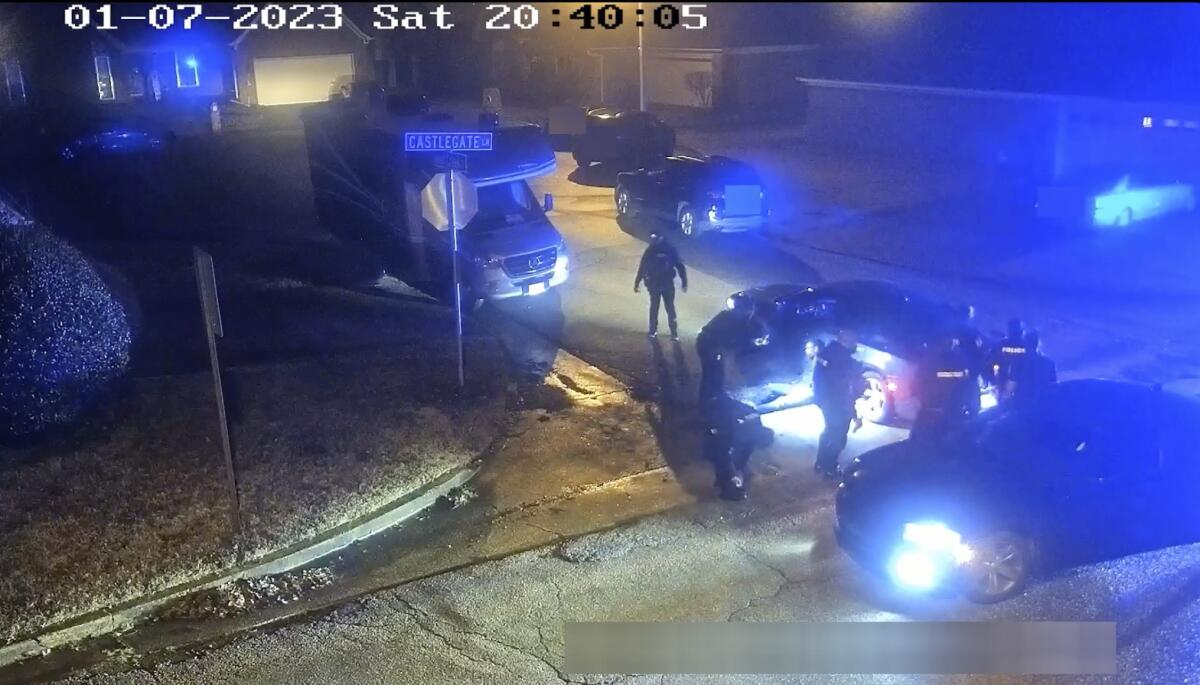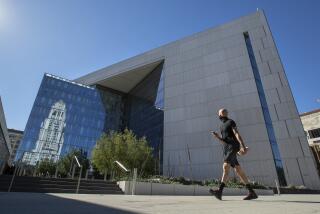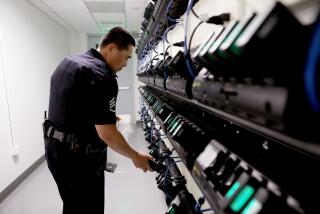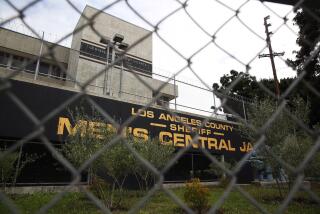LAPD edits police shooting videos as other cities embrace greater transparency

The videos Memphis officials released showing the fatal police beating of Tyre Nichols last month were striking not just for the viciousness they captured.
Running 67 minutes, the footage from cameras worn by some of the officers and a city-operated surveillance camera presented a raw, unedited look at police brutality.
The unfettered transparency earned the city’s police chief and other leaders grudging praise from Nichols’ family and law enforcement critics who said it should be a model for other police departments around the country.
Indeed, in Los Angeles, where the city’s Police Department releases heavily edited videos of shootings and other violent incidents involving officers, the decision in Memphis prompted a simple question: Why not here too?
As the LAPD and departments elsewhere wrestle with how much the public should see of violent police encounters — and how quickly they should see it — they do so knowing the stakes are undoubtedly high. Withholding too much or being slow in releasing videos of a controversial incident can further stoke the public’s anger and distrust.
California law requires police departments to release footage of most officer shootings and other serious uses of force within 45 days. There are no rules on what a department can and can’t show of an incident.
LAPD’s videos, uploaded to the department’s YouTube page, are typically narrated by the head of the LAPD’s media relations office and are compilations of footage from cameras worn by officers, recordings of 911 calls and dispatchers’ communications with officers.
The LAPD’s internal policy mirrors the 45-day time frame in the state law and requires video be released in all police shootings. A Times review of 41 videos from police shootings and other serious uses of force last year found they averaged 7½ minutes of the incident itself. And the average time between an incident and the release of the related video was about 35 days — nearly two weeks longer than it took to get the Nichols video out.
Before the Nichols video was released, LAPD Chief Michel Moore last month decided to move more quickly than usual. In the face of mounting public pressure, he ordered footage from three deadly encounters to be released a little over a week after they occurred. In one of the incidents, in which an officer repeatedly stunned a man with a Taser following a traffic accident, Moore opted to put out an additional 15 minutes or so of footage, in response to demands for transparency from both activists and the police union.
Until 2018, the LAPD had long resisted releasing images or video of critical incidents, even after it embarked on an ambitious effort to outfit thousands of its officers with body cameras. Department officials often cited a desire to protect victims’ privacy and the integrity of investigations for their decision to not release video. Then-Police Chief Charlie Beck expressed concerns about the public viewing video out of context and jumping to conclusions about what it shows.
Memphis officials’ handling of the Nichols case illustrates the current reality facing city leaders across the U.S.: The decision of when and how to release video of an incident brings with it its own perils, said Laura Cole, founder of Critical Incident Videos LLC, which advises local law enforcement agencies. Cole said she encourages the police and sheriff’s departments she works with to release unedited footage even if it shows officers in a bad light — advice that is rooted in the ethos of her former career as a TV journalist: Get the video out and let people decide for themselves.
“The videos should not be to spin anything, the videos should be to provide facts,” she said.
At the same time, she said there are legitimate reasons for why a department may delay posting of a video. Evidence gathered by investigators can change the understanding of what happened and releasing misleading video can do more harm than good, she said.
Capt. Kelly Muniz, who runs the LAPD’s Media Relations Division, said the video of a shooting that is released publicly closely “matches the presentation” the chief and the LAPD’s independent inspector general receive when they are briefed on a shooting or other serious incident. In some cases, the chief and inspector general offer feedback about whether the edited footage included in a video accurately convey what happened, she said.
The video compilations that are made public can take several weeks to produce as a four-person team in the LAPD’s media relations office works to add subtitles, blur witnesses’ faces, and record Muniz’s narration, according to Muniz. Department brass must sign off on a video before it is made public, she added.
The videos are based on preliminary information and are not intended to be “exhaustive,” but rather are meant to give viewers a clearer picture of the moment force was used, without having to sift through extraneous video of officers driving to the scene or standing around after an incident occurs, Muniz said.
“It’s comprehensive and digestible so that there’s some thread and understanding of what exactly transpired, because it can be confusing if you just dump a bunch of body camera video to make sure that the time stamps line up,” she said.
Videos are edited to help viewers understand what is happening in often chaotic, fast-moving encounters, she said. The video is often slowed down or frozen, and enlarged, to direct viewers’ attention to a weapon or other object a person was holding.
“If we played everything raw footage, without slowing down, and enhancing, it’s tough to see with the naked eye,” she said.
Most of the dozens of videos analyzed by The Times are edited in a way that shows at least some of the events leading up to officers using force. But some, like the footage from a June 8 police shooting in Hollywood, pick up just seven seconds before police fire the first shot at a man running away from them following a suspected burglary.
Other times, videos have injected uncertainty into an incident by not reflecting what police said occurred.
The “selective way in which” LAPD videos are edited can “define the parameters of the encounter” and subtly put forth a story line that makes officers’ actions appear justified or “deflect criticism” from the department itself, said Sahra Sulaiman, a reporter with StreetsBlog L.A. who often writes about police and transparency. By not releasing all relevant footage, the public has no way of assessing whether, for instance, officers may have unnecessarily escalated an encounter to the point where they felt a need to open fire, she said.
“In the video the narrative is very much that the subject is doing the escalation … and forced them into this difficult position where they had to use deadly force,” she said.
That point was driven home for her most recently after the release of body camera footage from the shooting in Leimert Park last year of Jermaine Petit, a mentally ill man who was shot after officers mistook the auto part he was carrying for a gun. The edited video and Muniz’s narration of what occurred do not specify which officers shot at Petit and do not make clear a sergeant who arrived late to the scene fired at Petit from inside his vehicle as he pulled up. Sulaiman only picked up on the crucial detail after she rewatched the video numerous times and spotted the reflection of the sergeant’s outstretched arm on a computer screen in his vehicle.
Shakeer Rahman, an attorney who has filed a lawsuit on behalf of Sulaiman and another reporter seeking unredacted footage of a 2020 police shooting, argued in court papers that the department’s truncated videos don’t satisfy Assembly Bill 748, the state law that requires video and audio from police body cameras and other law-enforcement recordings to be released within 45 days of an incident.
For the record:
12:05 p.m. Feb. 13, 2023An earlier version of this story incorrectly attributed the idea that the public shouldn’t have to file lawsuits to obtain unedited police video. Attorney Shakeer Rahman said this, not Sahra Sulaiman.
The public shouldn’t have to sue every time they want to obtain police video that hasn’t been edited, Rahman said, pointing out that other cities across the state such as Sacramento regularly release unedited footage.
Other cities have moved more quickly than the LAPD to make public videos of police shootings. Las Vegas, for example, has released them within 10 days. Salt Lake City has followed a similar time limit.
In Tucson, police Sgt. Richard Gradillas said a regional agency that local departments rely on to investigate shootings and other uses of force by police decides when to release video footage. Like L.A., Tucson police produce shortened videos that are edited down to include only the key moments of an encounter. The edits are not meant to promote a certain narrative, he said, but rather to spare viewers from having to watch dozens of minutes of video in which nothing is really happening.
“The reason why we edit those is obviously there are some graphic scenes that we don’t want the public to see,” Gradillas added.
In Charlotte, N.C., where state law requires a court order to release police videos, officials have struggled to find a balance between transparency and the broader impact of releasing upsetting, violent images, said Tonya Jameson, chair of that city’s civilian review board.
“I would hope that any city gives privacy considerations to a victim’s family. To me that outweighs the public’s need to know,” Jameson said. “You risk it becoming an even more tenuous situation when people can’t see for themselves. So I don’t know if there’s any way to win, not that it’s a game, but I don’t know how you do that dance really?”
She pointed to the Nichols case in Memphis, where for all the anticipation surrounding its release, some Black residents refused to watch the footage, calling it traumatizing and saying that they didn’t need to see the gruesome images to understand police brutality.
In Memphis, some have credited the city leaders’ decision to quickly release the Nichols footage with warding off the type of violent clashes between protesters and police that followed similar incidents in other cities.
But some in the city and beyond wondered whether the move was borne of self-preservation, in the face of an undeniable display of police brutality that drew national attention. They pointed to past police actions where the city had been slow to release video.
One such case involved a man named Martavious Banks, who was shot in the back after fleeing a traffic stop in 2018, prompting weeks of protests and demands for greater transparency. Police and the Banks family have given starkly different accounts of the shooting. Relatives say Banks was running away and posed no danger to the officers. Police say that officers opened fire because Banks was armed and a handgun was recovered at the scene with his blood on it.
The family later sued the city, eventually settling the matter out of court for $200,000. The officers involved were cleared of criminal wrongdoing.
Banks’ brother, Jamarious, 33, said that his family and its attorneys fought for years for the release of body camera footage from the incident, only to be rebuffed time and time again by the city. Authorities had already let on that some of the officers present switched off their cameras at times during the incident. The city finally released some video in November 2020, but it proved inconclusive.
“They took long enough for us to feel like they were trying to edit it,” Jamarious Banks said.
More to Read
Sign up for Essential California
The most important California stories and recommendations in your inbox every morning.
You may occasionally receive promotional content from the Los Angeles Times.











